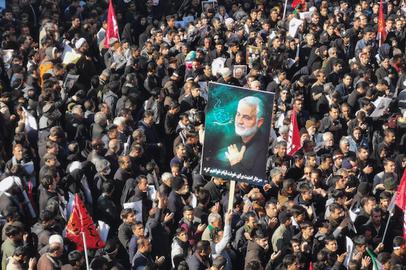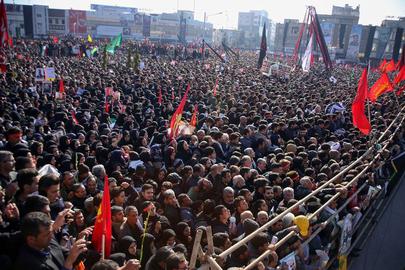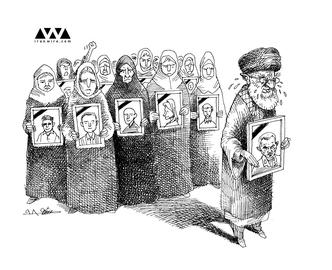At least 59 people have died and 215 have been injured while trying to attend the burial ceremony of Ghasem Soleimani in Kerman in southeastern Iran. Many of the victims were said to be elderly or young children.
Following the stampede, there has been widespread speculation that authorities ignored safety regulations in order to ensure as big a turnout as possible, and that there was extensive media coverage of the event. Reporting on Tuesday, January 7, the official Islamic Republic News Agency (IRNA) said security guards were to blame for the tragedy.
A few hours after the deadly stampede, one of the injured told IRNA that the incident occurred when security guards prevented people from crossing a section of Shariati Avenue. According to him, people rushed toward the avenue, but many of them lost their balance and fell to the ground when security guards blocked their access, leading to the deaths and injuries.
“If side streets had been open, the density of the crowd would have been lower but security personnel were adamant that people must return to the main street and that is why this tragedy happened,” he said. A number of other injured people confirmed this assessment.
"Unfortunately, a number of our compatriots lost their lives in Kerman due to the density and overcrowding," said Pir-Hossein Kulivand, the head of the country's emergency agency. He added that the injured had been taken to medical centers in Kerman. "We are investigating the extent of the incident and additional information will be provided as soon as the physical conditions of those injured are reported," he said.
The burial in Soleimani's home town of Kerman was postponed when news of the deaths emerged, and took place later in the day. President Hassan Rouhani and First Vice President Eshagh Jahangiri have ordered an investigation into the incident.
No Foresight, No Planning
There was a broad wave of criticisms on social media about the mismanagement of the funeral procession. Many asked why the organizers had failed to take the necessary precautions.
Mehdi Ali Ghanbarlou, a Mehr News Agency photographer, had warned the responsible officials of the potential danger, publishing photographs of the location of the ceremonies six hours before it was due to start. Ghanbarlou wrote that he was leaving the area so that he would not have to take photographs of the victims.
Mehdi Sadafi, head of Kerman’s Headquarters for Friday Prayers Ceremonies, held official responsibility for the organization of the procession. Thousands of people regularly take part in Friday Prayers ceremonies in Kerman.
It is still not clear what role the Revolutionary Guards, the police and other government agencies played in the funeral ceremonies for General Soleimani.
Soleimani, who was commander of the Revolutionary Guards’ expeditionary Quds Force, was killed on Friday, January 3, by an American drone strike as he was leaving Baghdad Airport. Since then burial ceremonies for him have been held in Mashhad, Tehran, Qom and Ahvaz, all without major incidents — there were reports of a few minor injuries, and eyewitnesses in Tehran said the ceremony there was chaotic.
Outspoken member of the parliament Ali Motahari was among those who criticized the way proceedings were handled in Tehran. “After reciting the Prayer for the Dead, we had a lot of trouble accompanying the body of the martyr [Soleimani] outside,” he posted on his Telegram channel under the title “A magnificent and disorderly farewell to the commander.”
“We thought that would go as far as Revolution Square and would then separate from the crowd. So we entered Revolution Street and then it became clear that the crowd was moving slowly. Then the pressure of the crowd rose little by little. I am not exaggerating when I say that when we reached Revolution Square I saw around 50 people who were almost suffocating and had no way to get out. I myself felt the same a few times. This happened with the [state] TV’s helicopter hovering over us and filming. I said to myself that the helicopter is taking pictures for [the media], disregarding how people are feeling down here. Apparently, we just want to show the size of the crowd to the world and we do not care how people are doing.”
“Violation of Sharia”
Motahari also called it “a violation of Sharia” that men and women were pushed together so closely, and added that officials responsible for the chaos have “injured the soul of the martyred Commander Soleimani” and must be held to account.
Friday Prayers are held each week in more than 700 Iranian cities, with between 100 and thousands people taking part. In addition, every year there are religious and political marches in the streets and a considerable number of people participate in such rallies. However, over the last 40 years there have been few reports of casualties due to crowd congestion. But very little guidance and information regarding the management of crowds is available from Iran’s public services organizations, including the websites of the Iranian Crisis Management Headquarters, the Red Crescent Society of Iran, municipalities, the Welfare Organization, the Civil Defense Organization and the Ministry of Interior.
Advice regarding crowd safety available elsewhere outlines the importance of assessing the number of people per square meter. The situation is regarded as normal if there are three people per square meter, but five people per square meter and higher is defined as overcrowding. If the number reaches five or eight, then the situation is considered to be serious, with people in danger of being crushed. If the concentration goes over 10 people per meter, the chances of death and injuries are very high.
Overcrowding is classified in two categories: Positive Force Change and Negative Force Change. The first type of overcrowding occurs when the crowd stops when it encounters a barrier or the way ahead is blocked. The second type happens when the crowd suddenly finds a way to move, as when a gate is opened or a fence is broken.
According to reports, what happened in Kerman was the second type, meaning that the crowd suddenly entered a street with not enough capacity to accommodate it, and casualties followed. Based on the media reports, the situation got worse when security guards prevented people from entering various side streets and alleys. As a result of lack of planning and foresight, at least 56 people have lost their lives and more than 200 have been injured.
Related Coverage:
Many Syrians Celebrate Assassination of a War Criminal, 6 January 2020
Will Soleimani's Death Intensify the Iran-US Proxy War in Afghanistan? 5 January 2020
Who is Ismail Qaani, the New Commander of the Revolutionary Guards’ Quds Force? 3 January 2020
Who was General Ghasem Soleimani: Murderer or Hero?, 3 January 2020
visit the accountability section
In this section of Iran Wire, you can contact the officials and launch your campaign for various problems


























comments